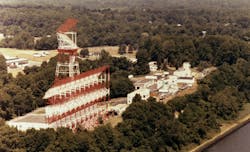Navy researchers ask Envisioneering to support over-the-horizon radar that relies on HF radio signals
WASHINGTON – U.S. Navy researchers needed to help develop a new prototype High Frequency (HF) over the horizon (OTH) radar system. They found a solution from Envisioneering Inc. in Alexandria, Va.
Officials of the Naval Research Laboratory (NRL) in Washington announced a $45.4 million contract to Envisioneering Inc. on Monday for design, development and integration of a mobile over-the-horizon radar (MOTHR).
Over-the-horizon radar typically uses HF radio signals at frequencies between 2 and 30 MHz to reach beyond the horizon in open-ocean areas. HF signals bounce off the ionosphere to achieve long distances and operate beyond the curvature of the Earth.
Envisioneering will work alongside the NRL research team to support key areas such as refinement of system requirements; system and subsystem design; mechanical analysis; specifying and procuring long-lead items; integration; testing; and signal processing.
The U.S. military has developed this kind of high-frequency radar before, in the 1980s-vintage Over The Horizon-Backscatter (OTH-B) radar, and the Navy's Relocatable Over-the-Horizon Radar (ROTHR) systems. Over-the-horizon radar bounces HF radio waves off the Ionosphere similar to shortwave radio.
HF-based over-the-horizon radar can provide long-distance surveillance over the oceans for ship and aircraft traffic, enemy cruise missiles, and illegal drug tracking.
Working with often-erratic and unpredictable HF radio signals demands substantial digital signal processing to overcome typical HF problems such as static interference and signal drift. Lightning almost anywhere in the world can interfere with HF signals, and HF is influenced heavily by daytime and nighttime conditions.
One of the latest U.S. military over-the-horizon radar projects is the Defense Applications of Innovative Remote Sensing (DAIRS) project of the U.S. Defense Advanced Research Projects Agency (DARPA) in Arlington, Va.
DARPA researchers are asking industry to develop signal processing for ocean ship and boat tracking using surface-wave over-the-horizon radar (SWOTHR) and environmental characterization. Primary emphasis will be in the high frequency (HF) band nominally at 4 to 15 MHz. Key applications in this frequency band are SWOTHR for aircraft, ship, and boat tracking, oceanographic SWOTHR, and sounding for ionospheric characterization.
For more information contact Envisioneering online at www.envisioneeringinc.com, or the Naval Research Laboratory at Paste link here.
About the Author
John Keller
Editor-in-Chief
John Keller is the Editor-in-Chief, Military & Aerospace Electronics Magazine--provides extensive coverage and analysis of enabling electronics and optoelectronic technologies in military, space and commercial aviation applications. John has been a member of the Military & Aerospace Electronics staff since 1989 and chief editor since 1995.
